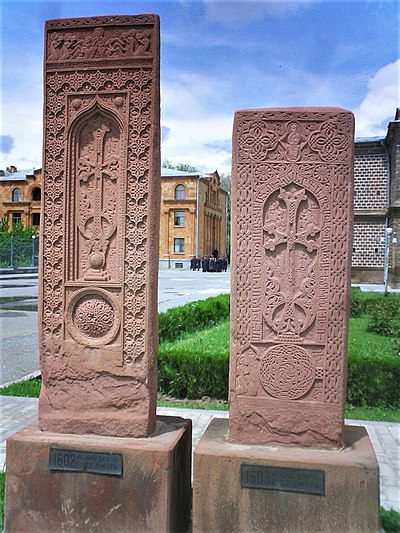Georgian mythology: Difference between revisions
Appearance
Content deleted Content added
No edit summary |
|||
| Line 1: | Line 1: | ||
[[File:Borjgali.svg|thumb|400 px|Borjgali - an ancient Georgian symbol of the Sun and is related to the Messopotamian and Sumerian symbols of the eternity and the Sun.]] |
[[File:Borjgali.svg|thumb|400 px|Borjgali - an ancient Georgian symbol of the Sun and is related to the Messopotamian and Sumerian symbols of the eternity and the Sun.]] |
||
The article is about the [[mythology]] of the country of [[Georgia (country)|Georgia]]. |
The article is about the [[mythology]] of the country of [[Georgia (country)|Georgia]]. |
||
[[File:Jugha-khachkar-CIMG1581.JPG|thumb|400 px|Borjgali grave stone on the right under.]] |
|||
Georgian myths and legends are preserved mainly as popular tales. Many of them have eventually fused with [[Christian]] legends. |
Georgian myths and legends are preserved mainly as popular tales. Many of them have eventually fused with [[Christian]] legends. |
||
Revision as of 16:17, 23 November 2009

The article is about the mythology of the country of Georgia.

Georgian myths and legends are preserved mainly as popular tales. Many of them have eventually fused with Christian legends.
The most known Georgian mythic characters include:
- Ali was a beautiful and temptress goddess of rivers and woods.
- Amirani, was a mythic hero, son of Dali and the hunter Darjelani. Prototype of Greek Prometheus.
- Armazi, god of gods..., the great gods, conquerors of the world, lighters of the sun, givers of rain, who cause the fruits of the earth to grow, was the main god in Kartli’s (Iberia) official religion established by King Parnavaz of Iberia (4th century, BC). According to the legend, an immense statue of Armazi was crushed by the lighting after St Nino’s pray. Armazi is also the name of an ancient fortress near Mtskheta that dates from the same period.
- Baaduri, was a warrior, son of the Gods, enemy of all evil.
- Dali, Deyla or Dalila, was the hunt goddess and 'lady of stones and animals'. She was believed to be a temptress and to have many love affairs with hunters brutally killing the traitors.
- Devi, giants, usually believed to be evil beings.
- Dilis Varskvlavi (the Morning Star), the winter god, was a servant of Tamar(i).
- Gatsi and Gaim, were gods in official Iberian pantheon according to the medieval annals.
- Iakhsari, mythic hero, was a son of Morige and a close friend of Baaduri.
- Kopala, was a mythic hero, mighty warrior (archer) and a demon killer.
- Lamara, goddess, was called ‘eye of the earth’.
- Leucothenia (the White Goddess), was a Greek name for Georgian (Kolkheti) goddess of sea.
- Morige, was creator, the Lord of the Sky sitting on a golden throne.
- Mzekhala (Sun-woman) was the Sun goddess, patroness of grape growing. Later identified with St Barbara (Barbare, Barbale in Georgian).
- Pirkhusha, was a smith, making Kopala’s arrows.
- Tamar, goddess of sky, riding on a snake, is identified with Lamara.
- Tetri Giorgi (White George), popular character in Georgian mythology, was a warrior and a moon god. Later Tetri Giorgi became one of the names of St George (Tsminda Giorgi) in the mountainous eastern Georgia.
- Zadeni, was the god of fertility in Iberian official pantheon established by Parnavaz I.
See also
